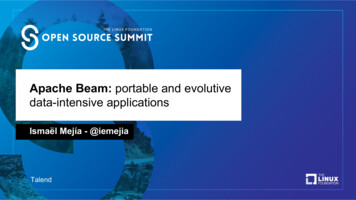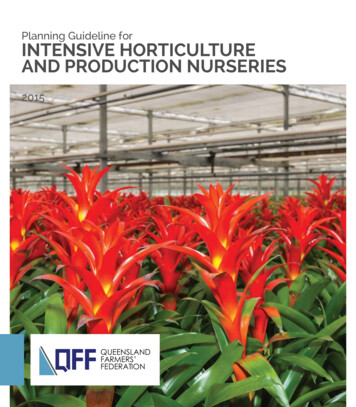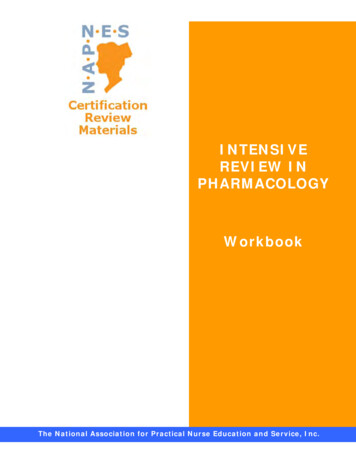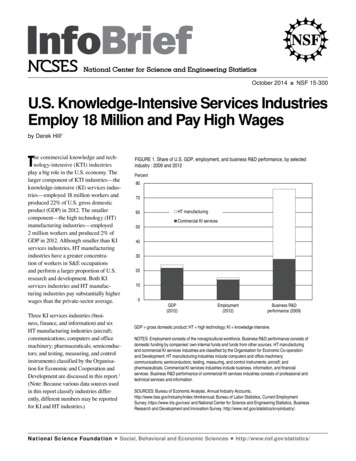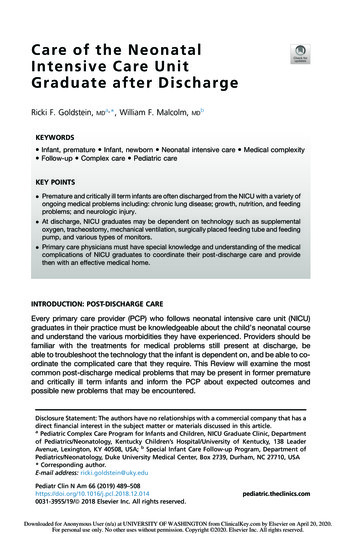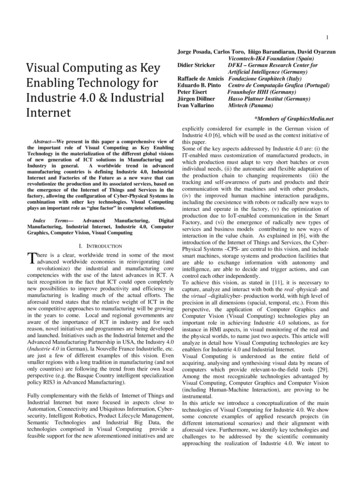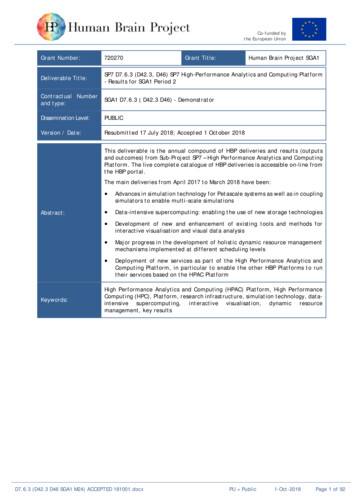
Transcription
Co-funded bythe European UnionGrant Number:720270Grant Title:Human Brain Project SGA1Deliverable Title:SP7 D7.6.3 (D42.3, D46) SP7 High-Performance Analytics and Computing Platform- Results for SGA1 Period 2Contractual Numberand type:SGA1 D7.6.3 ( D42.3 D46) - DemonstratorDissemination Level:PUBLICVersion / Date:Resubmitted 17 July 2018; Accepted 1 October 2018This deliverable is the annual compound of HBP deliveries and results (outputsand outcomes) from Sub-Project SP7 – High Performance Analytics and ComputingPlatform. The live complete catalogue of HBP deliveries is accessible on-line fromthe HBP portal.The main deliveries from April 2017 to March 2018 have been:Abstract:Keywords: Advances in simulation technology for Petascale systems as well as in couplingsimulators to enable multi-scale simulations Data-intensive supercomputing: enabling the use of new storage technologies Development of new and enhancement of existing tools and methods forinteractive visualisation and visual data analysis Major progress in the development of holistic dynamic resource managementmechanisms implemented at different scheduling levels Deployment of new services as part of the High Performance Analytics andComputing Platform, in particular to enable the other HBP Platforms to runtheir services based on the HPAC PlatformHigh Performance Analytics and Computing (HPAC) Platform, High PerformanceComputing (HPC), Platform, research infrastructure, simulation technology, dataintensive supercomputing, interactive visualisation, dynamic resourcemanagement, key resultsD7.6.3 (D42.3 D46 SGA1 M24) ACCEPTED 181001.docxPU Public1-Oct-2018Page 1 of 92
Co-funded bythe European UnionThe High Performance Analytics and Computing Platform achieved major progress inproviding the base infrastructure for the Human Brain Project during the last year. Newservices have been developed and made available in close co-design with the other HBPSubprojects that enable the other Platforms, in particular the Neuroinformatics Platform,the Brain Simulation Platform and the Neurorobotics Platform, as well as the Collaboratory,to run their services on the HPAC infrastructure (see section 2.5 for more details).Moreover, the visibility of the HPAC Platform, and of the HBP as a whole, has significantlyincreased in the High-Performance Computing community. One of the highlights of last yearwas the choice of the HBP as one of the two project examples for the #HPCconnectscampaign of the Supercomputing Conference 2017 (SC17). The picture above was takenduring a shooting for a movie on the importance of HPC for the HBP and neuroscience, itwas shown during the SC17 opening event.D7.6.3 (D42.3 D46 SGA1 M24) ACCEPTED 181001.docxPU Public1-Oct-2018Page 2 of 92
Co-funded bythe European omputationalcommunityWork-InitiallyPlannedDelivery PCSGA1 WPs 7.1, 7.2, 7.3, 7.4, 7.5, 7.6SGA1 M24 / 31 Mar 2018Thomas LIPPERT, JUELICH (P20), SP LeaderAuthors:Thomas SCHULTHESS, ETHZ (P18), SP LeaderAnna LÜHRS, JUELICH (P20), SP ManagerCompiling Editors:Anna LÜHRS, JUELICH (P20), SP ManagerJulita CORBALÁN, BSC (P5)Benjamin CUMMING, ETHZ (P18)Timo DICKSCHEID, JUELICH (P20)Markus DIESMANN, JUELICH (P20)Cyrille FAVREAU, EPFL (P1)Andreas FROMMER, BUW (P7)Cristian MEZZANOTTE, ETHZ (P18)Roberto MUCCI, CINECA (P13)Ralph NIEDERBERGER, JUELICH (P20)Boris ORTH, JUELICH (P20)Contributors:Dirk PLEITER, JUELICH (P20)Luis PASTOR, URJC (P69)Hans Ekkehard PLESSER, NMBU (P44)Raül SIRVENT, BSC (P5)Bernd SCHULLER, JUELICH (P20)Dennis TERHORST, JUELICH (P20)David VICENTE, BSC (P5)Thomas VIERJAHN, RWTH (P46)Benjamin WEYERS, RWTH (P46)Gabriel WITTUM, UFRA (P35)Felix WOLF, TUDA (P85)SciTechCoord Review:Editorial Review:EPFL (P1): Jeff MULLER, Martin TELEFONT, Marie-Elisabeth COLINUHEI (P47): Martina SCHMALHOLZ, Sabine SCHNEIDEREPFL (P1): Annemieke MICHELSD7.6.3 (D42.3 D46 SGA1 M24) ACCEPTED 181001.docxPU Public1-Oct-2018Page 3 of 92
Co-funded bythe European UnionTable of Contents1.2.Introduction . 5Results. 62.1 Simulation technology for Petascale systems: concepts, numerical algorithms and softwaretechnology . 62.2 Data-intensive supercomputing technology . 82.3 Interactive visualisation and visual data analysis . 102.4 Dynamic resource management tools and techniques. 192.5 High Performance Analytics and Computing Platform v2 . 223. Component Details . 273.1 Simulation technology for Petascale systems: concepts, numerical algorithms and softwaretechnology . 273.2 Data-intensive supercomputing technology . 403.3 Interactive visualisation and visual data analysis . 503.4 Dynamic resource management tools and techniques. 603.5 High Performance Analytics and Computing Platform v2 . 664. Conclusion and Outlook . 88Annex A: HPAC Platform usage . 90List of FiguresFigure 1: Participants of the NEST Conference 2017 . 7Figure 2: General visualisation software architecture in SP7 . 11Figure 3: Visualisations provided by RTNeuron . 13Figure 4: MSPViz . 14Figure 5: NeuroLOTs. 14Figure 6: NeuroScheme and ViSimpl. 15Figure 7: Visualisation of NEST simulation . 15Figure 8: PLIViewer . 16Figure 9: NEST in situ framework . 17Figure 10: Use of the multi-view framework for various use cases. . 18Figure 11: Scheduling levels in a supercomputing system . 21Figure 12: Usage of the OpenStack IaaS Cloud Infrastructure at ETHZ-CSCS by HBP at the end of SGA1. 91Figure 13: Usage of the Object Store at ETHZ-CSCS by HBP SPs at the end of SGA1 . 92Figure 14: Evolution of Object Storage at ETHZ-CSCS usage by HBP (March - May 2018). 92List of TablesTable 1: Usage of HPC systems by HBP during SGA1 . 90Table 2: Usage of the HPC storage by HBP at the end of SGA1 . 90D7.6.3 (D42.3 D46 SGA1 M24) ACCEPTED 181001.docxPU Public1-Oct-2018Page 4 of 92
Co-funded bythe European Union1. IntroductionThe mission of the High Performance Analytics and Computing (HPAC) Platform is to build,integrate and operate the base infrastructure for the Human Brain Project, together withFenix, a project that is about to start. The infrastructure comprises hardware and softwarecomponents, which are required to run large-scale, data-intensive, interactive simulations,to manage large amounts of data and to implement and manage complex workflowscomprising concurrent simulation, data analysis and visualisation workloads.During the last year, major progress has been made in all areas.The HPAC Platform has been extended with a set of new features, functionalities andservices. The most important achievement is that the Neuroinformatics Platform, the BrainSimulation Platform, the Neurorobotics Platform and the Collaboratory can run (part of)their services on HPAC infrastructure, which also ensures a close infrastructural link betweenthese other HBP Platforms, so that these can offer efficient, fast and scalable services totheir user communities. Key new elements are the now operational OpenStack serviceintegrated with the HPAC authentication and authorisation infrastructure, a flexible tool forcreating on-demand virtual computing infrastructure, the deployment of high-performancedata transfer services between HPAC sites, the availability of Object Storage and the abilityto mount HPC storage into Jupyter notebooks running in the Collaboratory.The HPAC Platform experts also develop new technologies that will be integrated into thePlatform, once they are mature. To ensure that all developments serve the requirements ofthe neuroscience community, they are co-developed with potential future users, who getaccess to the new services early during development.Data-intensive applications, like the analysis of data from experimental facilities such asbrain image scanners or simulations, play an increasingly important role. Ongoingdevelopment efforts focus on utilisation and management of hierarchical storagearchitectures, as well as data stores exploiting novel dense memory-based storage devicesfor such applications. Furthermore, software for coupling simulations and data processingpipelines, e.g. visualisation pipelines, has been developed.Supercomputers are typically operated in batch mode, i.e. users submit their jobs to a jobscheduler that tries to maximise the overall system usage. To reach a higher level ofinteractivity, for example to start an ad hoc visualisation during a simulation run, to have alook at the evolvement of the simulated network, this visualisation job needs to getscheduled instantaneously. A solution is to have a more dynamic resource management. Thishas to be implemented at different levels in the HPC system, as well as at the applicationlevel. The simulators NEST and Neuron have been prepared to support such resource sharing,and the job schedulers have been enhanced for this new type of resource management.We also made important progress on the development of application-level software thatneeds to be closely aligned with the infrastructure evolution. The NEST simulator nowsupports rate models of neuronal networks, the data structures have been revised to betterexploit the architecture of modern and future supercomputer architectures, and criticalbottlenecks in the construction of brain-scale networks were eliminated. NESTML, a domainspecific language for the specification of neuron models, has been advanced. MUSIC has beenused to couple NEST and UG4 to support multi-scale simulations. The Arbor library has alsobeen enhanced; the focus has been on optimising the kernels for target architectures suchas Intel KNL or NVIDIA GPUs, which are more and more often available as part of large-scaleHPC systems.Many developments in the HBP yield data sets that are too large to open and analyse withstandard viewers or visual analysis tools, be it ultra-high resolution imaging data or theresults of large-scale simulations. Therefore, major efforts have been spent on thedevelopment of interactive visualisation and visual analysis tools that are well integratedwithin the HPAC infrastructure, to make such large data sets usable for visual analysis. SomeD7.6.3 (D42.3 D46 SGA1 M24) ACCEPTED 181001.docxPU Public1-Oct-2018Page 5 of 92
Co-funded bythe European Unionof the tools can also be coupled to give users different data views at the same time to easeanalyses.2. Results2.1 Simulation technology for Petascale systems:numerical algorithms and software technologyconcepts,Building on over 20 years of experience in neuronal network simulation technology, we havetaken crucial steps to prepare NEST, The Neural Simulation Tool, for brain-scale simulationson future exascale high-performance computing systems. We focused on extending NESTcapabilities, based on requirements of users inside and outside the HBP, on multi-scaleruntime integration with other simulation tools, on facilitating the addition of new neuronmodels, and, in close collaboration with colleagues from the HBP Brain Simulation Platform,on preparing network creation and communication architecture of the simulation kernel forfuture exascale systems. Specifically, we extended NEST to support rate models of neuronal networks, thus permitting theinvestigation of network dynamics on the scale of spiking neurons, the classic domain ofNEST, and the more abstract scale of rate models; integrated the NEST and UG4 simulators via the MUSIC library to support multi-scalesimulations coupling network dynamics in NEST with detailed solutions to the 3D cableequations in UG4; developed NESTML as a domain-specific language for the specification of neuron modelsand implemented a tool generating optimized C code to add neuron models specifiedin NESTML to the NEST simulator; eliminated critical bottlenecks in the construction of brain-scale networks requiring avery large number of parallel processes; analysed user requirements for connectivity generation, drafted a more flexible andpowerful user interface for neuron and connection instantiation; collaborated with the Brain Simulation Platform on revised data structures forconnection representation and communication patterns, to allow NEST to exploit the fullpower of future exascale architectures; systematically reviewed all new code contributions to the NEST simulator in formalised,continuous integration based review processes in collaboration with the NEST developercommunity.We integrated our activities closely in the NEST user community within and outside the HBPby means of systematic monitoring and follow-up of user requests and proposals through the NESTmailing list and issue tracker; regular open NEST developer video conferences (every second week); personal contact with and support to key NEST users in the HBP, especially in the HumanBrain Organization, Systems and Cognitive Neuroscience, and Theoretical NeuroscienceSubprojects; organisation of an annual NEST Conference (before the 2017 NEST User Workshop), incollaboration with the NEST Initiative, bringing together users and developers for intenseexchanges of success stories, challenges and ideas.D7.6.3 (D42.3 D46 SGA1 M24) ACCEPTED 181001.docxPU Public1-Oct-2018Page 6 of 92
Co-funded bythe European Union2.1.1 Achieved Impact NEST is a well-established simulation tool for large neuronal networks, with users frominside and outside the HBP Newly introduced abilities, e.g. the ability to simulate rate-based models with NEST,have been received eagerly by the community and have already led to publicationscurrently under review: Jordan et al. 2017 https://arxiv.org/pdf/1709.05650.pdf Senk et al. 2018, https://arxiv.org/pdf/1801.06046.pdf Senden et al., 2018 pull/46 Code generation using NESTML has significantly reduced the burden of porting existingnetwork models to NEST, and thus facilitates model porting efforts in Systems andCognitive Neuroscience, as well as outside the HBP. The close interaction between NESTML developers in the High Performance Analytics andComputing Platform and NESTML users in Systems and Cognitive Neuroscience has driventhe development of NESTML further and ensured that NESTML addresses the needs ofcomputational neuroscientists.Figure 1: Participants of the NEST Conference 20172.1.2 Component DependenciesComponentID510Component NameContinuouscode in NESTdynamicsD7.6.3 (D42.3 D46 SGA1 M24) ACCEPTED 181001.docxHBPInternalNoCommentProvides support for rate-based models in NESTPU Public1-Oct-2018Page 7 of 92
Co-funded bythe European UnionNo567Report on numericaltechniques for stochasticequations of No520Report on multi-scalechallenges in the HBPsimulator hierarchyYes519Reportonneuronalmodelling languages andcorrespondingcodegeneratorsNo(oncepaper isout)209NEST – The NeuronalSimulation ToolNoKey software component of the HBP for simulationof networks of simplified neurons518CommunityestablishedNESTcontactsrelated toNoEnsure good contacts and information flowbetween NEST users and developers, both withinand beyond the HBP622NESTRequirementsManagementNoProvide a single contact point for handling userrequirements and forwarding them to developers.661NESTSupportProvidersforNoSupport system operatorsproviding NEST to users.660NESTSupportModellersforNoSupport users in using NEST, especially in portingexisting models to NEST.Mathematical and algorithmic foundations of ratebased modelling in NESTProvides support for integrating NEST and UG4simulationsBackground analysissimulator interfacetopreparesimulator-Fundamentals of NESTML language and codegeneratorin installingand2.2 Data-intensive supercomputing technologyData-intensive applications needing HPC resources have been identified as one of thechallenges of the HBP, which need to be taken into account for further evolution of theHPAC Platform and the upcoming ICEI/Fenix infrastructure.Our approach was use case driven. The following use cases have been addressed: Deep learning on large images Parallel image registration Cell detection and feature calculation Visualisation of compartment dataThe work focussed among others on enabling the use of new storage technologies. Newstorage devices based on dense and non-volatile memory technologies provide much higherperformance, both in terms of bandwidth as well as IOPS (input/output operations persecond) rates, while compromising on capacity. To provide access to storage devicesintegrated into HPC systems, like the HBP PCP Pilot systems, a variety of technologies havebeen deployed, explored and enhanced, ranging from parallel file systems like BeeGFS, newobject store technologies like Ceph, key value stores (KVS) enhanced by powerful indexingcapabilities, to technologies like IBM’s Distributed Shared Storage-class-memory (DSS).High-performance non-volatile memory is a precious resource, therefore, its co-allocationtogether with compute resources becomes necessary. Scheduling strategies for specificD7.6.3 (D42.3 D46 SGA1 M24) ACCEPTED 181001.docxPU Public1-Oct-2018Page 8 of 92
Co-funded bythe European Unionscenarios based on the needs of use cases have been developed and evaluated usingsimulators.Specific data analytics workflows have been considered and implemented in co-design withdata analytics experts.Tests and performance explorations were performed on the pilot systems JULIA and JURONinstalled at Jülich Supercomputing Centre (JUELICH-JSC). JULIA is a Cray CS-400 system withfour DataWarp nodes integrated, each equipped with two Intel P3600 NVMe drives. Theseand the compute nodes were integrated in an Omnipath network. Ceph was deployed on theDataWarp nodes. The other system, JURON, is based on IBM Power S822LC HPC (“Minsky”)servers. Each server comprises a HGST Ultrastar SN100 card. On this system BeeGFS, DSS anddifferent key value stores were deployed.2.2.1 Achieved ImpactThe work related to this key result laid the basis for integration of hi
Supercomputers are typically operated in batch mode, i.e. users submit their jobs to a job scheduler that tries to maximise the overall system usage. To reach a higher level of interactivity, for example to start a


